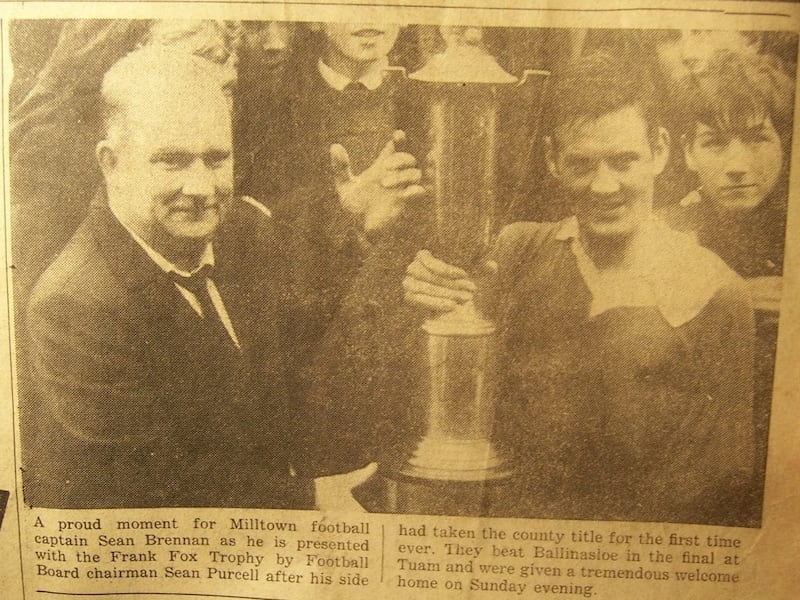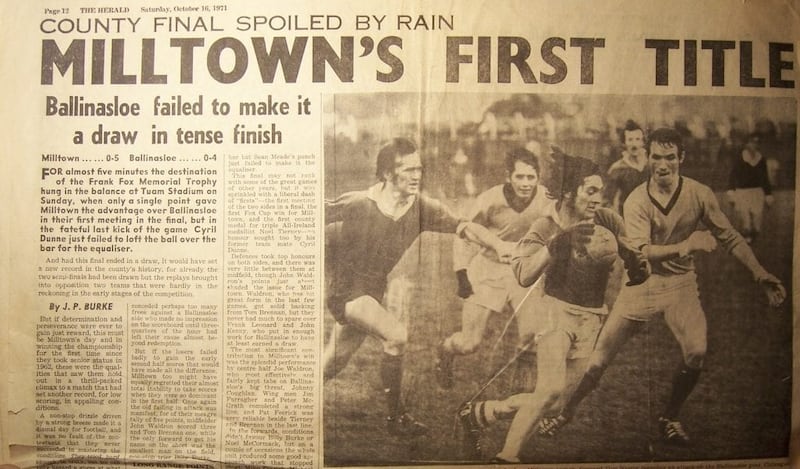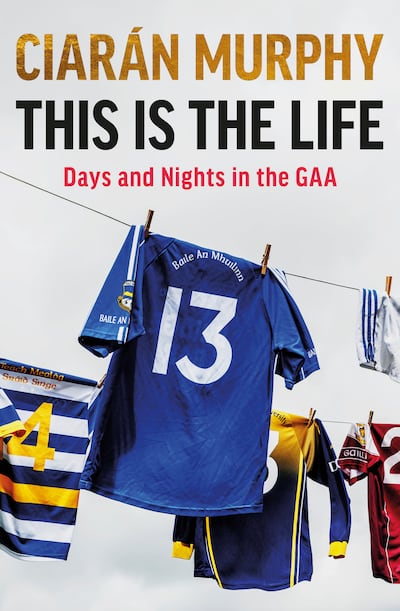When you hear people say “this is the life”, it usually means they’re doing something they don’t often do – drinking wine in a palazzo in Florence, or dipping their toe in the Pacific Ocean. Moments like those were not really to the forefront of my thinking when I was picking the name for my debut book.
Because the book is instead about the countless number of days I’ve spent invested in the Gaelic Athletic Association, encompassing the full breadth of my experience as a player, as a supporter, and as a journalist covering it on air and in print for the last 20 years. I wanted to bring to the page the everyday experience of the 99 per cent of GAA members who are not the superstar player, or famous manager.
And in interrogating my conflicted feelings around aspects of the GAA – the hypocrisy around money, the on-pitch violence, the emotional blackmail – I nevertheless come to a conclusion of sorts, encapsulated in the life of Seán Brennan.
After my 2022 club season finished, I spent a few weeks at home in Milltown with my parents working on this book. In the middle of October, I was sitting at the bar in Mullarkey’s with Dad. I was flanked on my other side by John Waldron, and it just so happened that a couple of weeks after this night, my father and John would be the joint recipients of a Hall of Fame award from the club.
They had been told about the award well in advance, and so had plenty of time to figure out a list of people more deserving of the honour than they were. Drawing up that list was exactly what they were doing on that night in mid-October. Foremost in John’s mind was Seán Brennan, the captain of the first Milltown team to win the county senior championship.
There’s a photograph of Seán being presented with the Frank Fox Cup by then-Galway football board chairman Seán Purcell – often proclaimed, as we have heard, the best footballer of the 20th century. In the photo, Brennan looks almost impossibly handsome as he receives the trophy, an Elvis Presley mop of jet-black hair slick and wet from the day’s rain. He holds the trophy at its middle with one hand, the reason for which becomes clear on closer inspection. His left jersey sleeve is empty at the wrist. He has only one hand.

I had known this fact about our first county title-winning captain for my entire life. If you’d asked me that night last October, I’d have said that he had emigrated as a young man and lost the hand in a cotton mill in Birmingham. (This is actually what happened to Michael Davitt, who founded the Land League in Irishtown, no more than three miles down the road from my location that night in Mullarkey’s – funny the tricks your mind plays on you.)
But John was there, talking away to me about Seán Brennan, about what an exceptional footballer he was, that he came on in the All-Ireland semi-final of 1963 for Galway against Kerry, which I’d never known. And then John told me that for 10 years after the accident that cost Seán his hand, he bent down and tied Seán’s bootlaces before every game they played together.
That detail knocked me out. I couldn’t stop thinking about it. I couldn’t stop thinking either about how I’d always known about Seán’s injury yet never really thought about it. Of course someone had to tie his bootlaces for him.
I met Seán a few months later. He’s retired now, and lives in Caherlistrane, about 15 miles from Milltown, and he told me the true story of what happened to his left hand as coolly and calmly as if he was talking about a scene from a movie.
On March 18th, 1964, he was studying to be a priest in All Hallows College in Drumcondra. He had been the stage manager for a production of Macbeth, performed the day before, and on the day of the accident he was dismantling the set with four other students. One of them asked how they had created the big flash of fire in the famous witches’ cauldron. To demonstrate, he poured magnesium powder on to a piece of cardboard, and someone held a match to it to cause the fire. Nothing happened, so Seán poured some more magnesium powder on to it. The can exploded in his hand.
The blood loss was extreme. One of the other students with him was his younger brother Gabriel, and he rushed Seán down to the infirmary, where his condition was so grave that he was given the last rites. He went to the Mater hospital and was operated on that night. They amputated his arm from a point about halfway between his elbow and his wrist.
He was visited in the Mater by some priests from the college, but when he went from there to the National Rehabilitation Centre in Dún Laoghaire, no one came to see him for six weeks. He left the seminary and returned to Milltown that summer a physical wreck, with shrapnel still all over his body, and 12 stitches in an ugly wound on his neck that was millimetres from a main artery. He had lost two stone.
He went back to his parents’ house. His mother had given birth to his youngest brother, Gerry, the day before the accident, and she was not informed of Seán’s injury for a number of days, as it was felt she had enough to deal with. It was an unbearably traumatic time for his family. The village was devastated also. My aunt was a boarder in the Mercy Convent in Tuam that spring, in the same year as Seán’s sister, and she remembers hearing about it and bursting into tears.
Seán was depressed, wrestling with the end of his college life (he said he would probably have left the seminary that summer in any case, but obviously not under such traumatic circumstances), and wrestling too with the idea of figuring out what he could do with the arm and the life he had left. He went to a tournament game the Milltown senior team were playing in south Mayo, and he overheard two men talking about “young Brennan – the poor lad will never play again”.

That he was being talked about like this, in a county other than his own, is not surprising, because Seán was a genuinely top-level talent. He was still a student at All Hallows when he had been brought on as a substitute in that All-Ireland semi-final in 1963. Galway won that day, only to lose the final to Dublin, but they were about to embark on the most successful period of their entire history, and Seán, aged just 21 at the time, undoubtedly had the ability to have played his part.
Seán played alongside his clubmate and first cousin Noel Tierney in the Galway defence against Kerry on that day in 1963. Thirteen months later, Tierney was full back again as Galway won the first of three All-Ireland titles in a row. That winter, while Seán recuperated, Tierney would be named the Texaco Footballer of the Year, the ultimate individual honour for a Gaelic footballer at that time. Seán was a huge supporter of that Galway team, and was at all those finals, but he admitted to shedding a tear or two as he saw them climb the steps of the Hogan Stand.
Whether inspired by the words of those men at the tournament game in south Mayo, by the success of his erstwhile Galway team-mates, or by a drive that seemed fundamental to him, in that winter of 1964 Seán started kicking a ball around at home, relearning how to play the game that he loved. An idea began to crystallise.
When the Milltown junior team were short a player for a game in the summer of 1965, he saw his chance. He walked into the dressing room, and no one said a word to him about his missing hand. He went out on to the field, and none of his opponents broached it with him, on that day or any other day.
He told me about the difficulties he faced during a game. The pain that shot through his body on the rare occasion he landed on the sharp point of his amputated forearm. The method he devised to pick up the ball in open play, scooping the ball from his left foot into his right hand, something he honed so expertly that he could lift the ball quicker than any two-handed player. The way any forward he ever marked automatically ran at his weak side when he was playing left corner back, thoughtlessly heading out towards the sideline, where he could then hit them hard and fair over the line.
His story was written about a bit at the time, when Milltown won the 1971 county final. There was an article with him in one of the GAA periodicals of the era, a paragraph about him in the Irish Echo in the US even. Bravery, resilience, dedication – these words all seem to fall far short of what he had shown.

He told me, in short, that football saved his life. If he could go back and play football, what was stopping him from doing anything else? He got a job with a construction company in Dublin, got married, had two kids. He moved down to north Galway in 1988. He now leads an almost picture-book ideal of country life with his lovely wife Mary. There is a polytunnel in the back yard, hens, and an extraordinary brightly coloured rooster, a beautiful golden pheasant, in a coop by the back door. He keeps bees and makes honey. Jam he makes from the strawberries in the polytunnel. The dog happily chasing around the place is called Mil, the Irish word for honey.
Mostly what I saw was a man now into his eighties who looked back on his football career with quiet pride and satisfaction. The photos of winning Milltown teams hang in his front hall, including the famous photo of him and Purcell with the Frank Fox trophy. He is one of the most self-assured, upbeat, sincere people I’ve ever met. It was genuinely a privilege to spend time in his house.
Believe it or not, I played senior football for Milltown with Seán Brennan’s youngest brother, Gerry, the boy born the day before Seán’s accident. Seán is twice my age now, and Gerry was twice my age when I first played with him, but we have that link. I haven’t lived in Milltown for over two decades, and I’ve been resident in Dublin now for longer than I lived in the village I was born in. After all I’ve seen and lived through and loved and hated about the GAA (the emotional blackmail, the hypocrisy, the casual attitude to discipline, the self-congratulation), I can’t get past that image of Seán in the dressing room, never needing to ask anyone for help as he got ready. Someone – John Waldron, or Pat Feerick, or one of his own brothers – was always there for him.
Extracted from This is the Life by Ciarán Murphy which is published by Sandycove on September 21st at €16.99




















